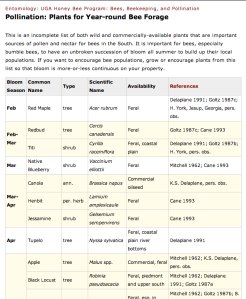Providing our bees with abundant, natural nutrition is by far the most important task of the beekeeper — far more important than hive inspections, equipment, medications, or any of the other things we spend a lot of time with.

What if we could provide that natural nutrition all year long — or 10 months out of 12?
Keith Delaplane, bee scientist at the University of Georgia, has put together a chart of plants that bloom from January to October in our part of the country that give bees the nectar and pollen they forage for. It’s worth a look. (Click on the image to the right to go there.)
It is important for bees, especially bumble bees, to have an unbroken succession of bloom all summer to build up their local populations. If you want to encourage bee populations, grow or encourage plants from this list so that bloom is more-or-less continuous on your property. (quoted)
The chart is revealing because it lists some things we might not think about. Henbit, for instance, comes up in abundance around where we live as early as late February. By March, the ground is covered with its purple flowers. Many people see henbit as a nuisance, but the bees — with nothing else to feed on — are all over it whenever it’s warm enough to fly outside the hive. If you look closely, you’ll see them packing up their pollen sacks with pollen from the henbit and carrying it back to the hive.
As soon as other things begin to come up, the bees will abandon the henbit, but when it’s the only thing around, the bees love it.
One of the very critical times for the bees is mid to late summer when most of the clover has died out. There are a number of plants on the chart that can help beekeepers fill in this gap.
One of the things that doesn’t appear on Delaphane’s list is buckwheat, something that we have written about extensively before. Buckwheat can carry blooms from whenever it’s planted to the first frost.
The goal is to allow the bees to store as much honey and pollen in the hives as possible, helping them increase the population and giving them the food they need to make it through the winter.
And here are a couple of other lists of blooms for bees:
Agricultural Research Service, USDA: http://www.ars.usda.gov/Services/docs.htm?docid=12052
North American Nectar Sources for Honeybees: http://en.wikipedia.org/wiki/Northern_American_nectar_sources_for_honey_bees


Key words: good nutrition for bees, year-around nutrition for bees, flowers and plants for bees, bee-friendly, goldenrod, red maple blooms, Keith Delaplane, beekeeping, chart of plants that bloom for bees, buckwheat, henbit, bunblebees, late-summer blooming plants, honey, pollen, nectar sources, Agricultural Research Service,